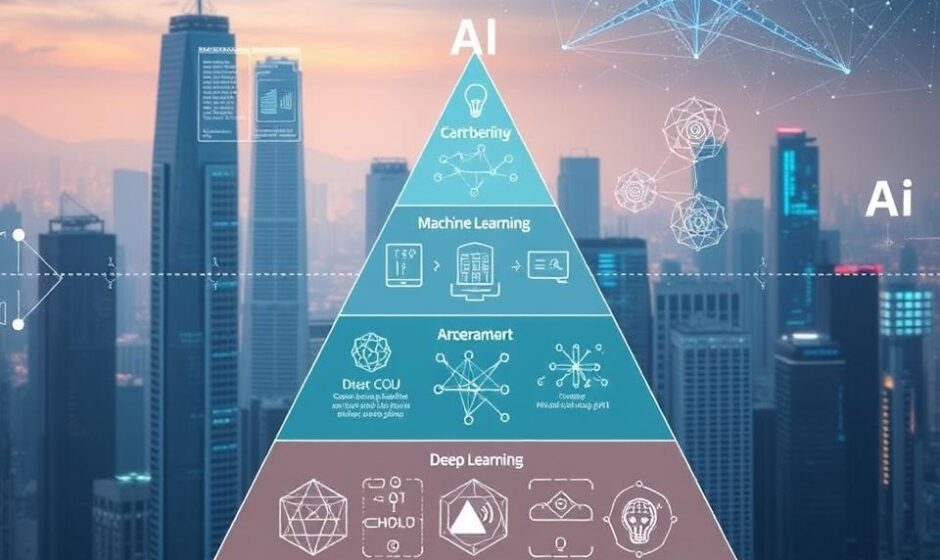Did you know over 70% of Americans use AI every day? They do this through voice assistants like Alexa and Siri. But, only about a third of them know the difference between AI and machine learning. This shows we need to clear up these tech terms.
From IBM’s Deep Blue beating chess champion Garry Kasparov in 1997 to AlphaGo winning Go in 2016, AI has made big strides. These achievements show how AI, machine learning, and deep learning change our world. Yet, many people don’t understand their differences.
Artificial intelligence (AI) lets machines make decisions like humans. Machine learning (ML) is a part of AI where systems get better with data. For example, spam filters get smarter over time.
Deep learning (DL) is a special ML method. It’s behind big advances like facial recognition and self-driving cars. This article will explain their roles, from history to today’s uses. You’ll learn how to use their strengths for your needs.
Key Takeaways
- AI includes all intelligent systems, while ML and DL are specialized methods within it.
- Deep Blue used early rule-based AI, whereas AlphaGo relied on deep learning to outthink humans.
- Machine learning automates data analysis, while deep learning handles complex patterns like images or speech.
- ai learning tools now drive innovations from healthcare to finance, yet their distinctions shape real-world impact.
- Understanding these layers helps businesses choose the right ai learning strategy for their goals.
Understanding the Foundations of AI and Machine Learning
Learning the basics of AI and machine learning starts with understanding what they are. This section explains key concepts and how they evolved from early experiments to today’s breakthroughs. Knowing these basics is essential for anyone interested in artificial intelligence training or tech careers.

Defining AI, Machine Learning, and Deep Learning
Here’s what each term means:
- Artificial Intelligence (AI): Systems designed to perform tasks requiring human-like intelligence.
- Machine Learning (ML): A subset of AI that teaches systems to learn from data without explicit programming.
- Deep Learning (DL): A ML method using layered neural networks to analyze vast datasets.
Historical Perspective of AI Development
Key milestones shaping AI’s evolution:
| Year | Event | Impact |
|---|---|---|
| 1956 | Dartmouth Conference | Birth of AI as a formal research field |
| 2011 | IBM Watson wins Jeopardy! | Showcased real-world AI capability |
Key Terminologies Explained
Terms to know:
- Training Data: Data used to teach models, central to artificial intelligence training processes.
- Neural Networks: Structures mimicking human brain pathways to process information.
- Algorithms: Step-by-step instructions guiding AI decision-making.
Exploring Deep Learning: Concepts and Applications
Deep learning is a part of machine learning that uses neural networks to solve tough problems. Start with deep learning tutorials from places like TensorFlow. They give step-by-step guides on neural networks and image recognition. Tools like IBM’s open-source projects let users try out real-world data, making theory a reality.
Deep Learning Tutorials and Resources
Google’s TensorFlow offers interactive deep learning tutorials. They cover everything from the basics to advanced topics like natural language processing. IBM’s AI Exchange has hands-on labs for building models in healthcare diagnostics or climate modeling.
Real-World Implementations
Deep learning is making big changes in important fields:
- Healthcare: AI checks medical scans to find tumors early, helping people live longer. IBM’s Watson Health uses neural networks to speed up finding new drugs.
- Agriculture: AI drones and sensors help crops grow better, saving resources. Companies like John Deere use deep learning to guess how much crops will yield.
- Environmental Conservation: Google’s Earth Engine uses AI to watch over deforestation. Microsoft’s AI for Earth program helps track biodiversity.

Future Trends in Deep Learning
Here are some trends to watch:
- Healthcare: AI could cut down on wrong diagnoses by 40% by 2025, says IBM’s research.
- Agriculture: Self-driving tractors and AI weather forecasts might increase global crop yields by 20% in a decade.
- Environmental Conservation: Deep learning will power real-time climate models. This will help governments make better sustainability plans.
Learning deep learning tutorials today prepares you for tomorrow’s tech, medical, and environmental challenges.
The Evolution of Artificial Intelligence Training
Early AI systems were based on strict, human-made rules to solve problems. Later, they turned into self-learning systems that use data. Companies like IBM led the way in generative AI. They made models like Watson that could analyze huge datasets and predict outcomes without needing to be told how.

| Era | Training Method | Key Applications |
|---|---|---|
| Rule-Based (1950s–1980s) | Manual rule creation | Basic decision-making tools |
| Machine Learning (1990s–2010s) | Data-pattern recognition | Email spam filters, movie recommendations |
| Deep Learning (2010s–Now) | Neural networks | Medical imaging analysis, chatbots |
Today, AI makes a big difference in how businesses work. Banks can catch fraud in seconds with AI. Hospitals use AI to look at scans and suggest what’s wrong. Retailers can guess what customers will want next, and factories can keep their equipment running smoothly.
For AI to be trusted, it needs to be clear. Explainable AI (XAI) tools help people understand why AI makes certain choices. This makes sure AI is used right and follows the law. It also helps teams work better with AI.
Machine Learning Courses and Certification Programs
Machine learning courses give you flexible ways to learn technical skills. Sites like Coursera and edX work with top universities. They offer structured learning paths. Getting certifications from trusted sources can boost your career, showing you know algorithms, data analysis, and how to deploy models.

| Course Name | Provider | Features |
|---|---|---|
| Machine Learning Specialization | DeepLearning.AI | Cover fundamentals to advanced neural networks |
| Stanford Machine Learning | Stanford University | Includes programming assignments and real-world case studies |
| Google IT Support | Includes hands-on labs and career coaching |
Benefits of certifications include:
- Industry-recognized credentials
- Access to peer networks
- Opportunities for specialization
When picking courses, think about:
- Align with career goals
- Check instructor expertise
- Verify hands-on project availability
Udacity and Fast.ai offer specific paths for all levels. Mixing theory with practice keeps your skills sharp in a rapidly changing field.
Deep Dive Into Neural Networks Programming
Neural networks programming creates smart systems like the human brain. These systems handle data in layers of connected nodes. Big names like Google and IBM use it for tasks like recognizing images and understanding language.

| Component | Function |
|---|---|
| Input Layer | Receives raw data like pixels or text |
| Hidden Layers | Process information through mathematical operations |
| Output Layer | Generates final predictions or classifications |
Programming these systems involves three main steps:
- Define the network structure (layers and connections)
- Choose activation functions for each node
- Train the model using datasets and backpropagation
Backpropagation helps improve accuracy by adjusting errors during training. Tools like TensorFlow make this easier. They let developers focus on solving problems, not just coding.
Even beginners can start with prebuilt templates. These templates handle complex math automatically.
Neural networks programming is key to innovation. Google uses it for search, and IBM for healthcare. To master it, you need to understand data flow, optimization, and testing.
AI Education Platforms and Data Science Bootcamps
AI education platforms and data science bootcamp programs are closing the gap between theory and practical skills. They offer flexible learning paths for those wanting to dive into AI. Platforms like Coursera and Udacity provide structured courses. On the other hand, bootcamps like Springboard focus on hands-on training.

| Platform | Focus Areas | Key Features |
|---|---|---|
| Coursera | Machine Learning, AI fundamentals | University-backed courses, flexible schedules |
| Springboard | Data Science, Deep Learning | Project-based learning, career support |
| Fast.ai | Practical AI coding | Free resources, community-driven |
Many opt for data science bootcamp programs for their fast and career-focused nature. These programs include mentorship and capstone projects. They help learners apply concepts like neural networks or predictive modeling.
Exploring Top AI Education Platforms
- Coursera: Partners with top universities for certification tracks
- Udacity: Nanodegrees with industry-aligned projects
- edX: Free courses from MIT, Berkeley, and IBM
The Role of a Data Science Bootcamp
“Bootcamps turn learners into problem-solvers by focusing on tools like Python and TensorFlow.”
Balancing Theory and Practical Skills
- Start with foundational courses on platforms like Kaggle Learn
- Join data science bootcamp modules for coding labs
- Build a portfolio using open datasets
Integrating AI Learning in Real-World Projects
Turning AI knowledge into action starts with real-world application. Businesses today are transforming ideas into innovations by embedding AI into daily operations. Platforms like Coursera and Udacity’s ai education platform offerings provide pathways to bridge theory and practice, preparing teams for hands-on projects.

Leveraging AI Learning for Business Innovation
Companies like Netflix use recommendation systems powered by machine learning to boost user engagement. Amazon’s product suggestions leverage similar techniques, driving sales through predictive analytics. These examples show how AI isn’t just technical—it’s a strategic tool for growth.
Case Studies from Industry Leaders
- Retail: Walmart reduced supply chain delays using AI-driven demand forecasts.
- Healthcare: Babylon Health deployed AI chatbots to improve patient support efficiency.
- Finance: JPMorgan Chase automates loan approvals with AI models trained on vast datasets.
Best Practices for Successful Integration
Start small. Test AI solutions on pilot projects before scaling. Partner with ai education platform providers to upskill teams. Continuously refine models with feedback loops. Remember: success comes from aligning AI goals with business objectives.
Comparing Machine Learning, Deep Learning, and AI Methodologies
Choosing the right approach for your project starts with understanding how AI, machine learning (ML), and deep learning (DL) differ. This section breaks down their methodologies, strengths, and limitations to guide informed decisions.

Side-by-Side Analysis of Techniques
- AI: Broadest category covering any system mimicking human intelligence, from chatbots to recommendation engines.
- Machine Learning: Subset of AI focused on algorithms improving through data, like fraud detection models.
- Deep Learning: Specialized ML using neural networks for complex tasks, such as image recognition in healthcare diagnostics.
Pros and Cons of Each Approach
AI offers flexibility but requires clear goals to avoid scope drift. Machine learning excels with structured data but needs extensive training datasets. Deep learning delivers high accuracy for unstructured data but demands significant computational power.
Determining the Right Fit for Projects
A successful strategy starts with project goals. For AI certification program graduates, applying these distinctions ensures tools match objectives. Retail teams might use ML for inventory forecasts, while self-driving cars rely on DL’s neural networks. Prioritizing scalability, data type, and resource availability prevents mismatches.
Overcoming Challenges in AI Implementation
Deploying AI is more than just coding. It’s a journey with many hurdles. But, with the right strategy, organizations can overcome these challenges. Let’s explore how to face these obstacles head-on.

Common Pitfalls in AI Deployment
Data bias and unclear decision-making often hinder teams. Here are the key issues to watch out for:
- Data bias: Unchecked biases in training data skew results.
- Transparency gaps
- Overcomplicating solutions: Complex models may fail in real-world settings.
: “Black box” models make decisions hard to explain.
Strategies to Mitigate Risks
Start smart and stay adaptable:
- Begin with small pilot projects to test assumptions.
- Train teams on ethical AI principles and tools like IBM’s AI Fairness 360.
- Use tools like Google’s What-If Tool to audit models for fairness.
| Pitfall | Action Plan |
|---|---|
| Data Bias | Regular audits with fairness metrics |
| Transparency | Adopt explainable AI frameworks |
| Overcomplication | Prioritize simplicity in initial phases |
“Ethical AI isn’t optional—it’s the foundation for long-term trust.” – IEEE Ethics in Action Report
Success depends on teamwork between data scientists and business teams. Celebrate small wins to build confidence and improve processes step by step.
Conclusion
Understanding AI, machine learning, and deep learning is key to their power. AI sets the stage, machine learning digs into data, and deep learning handles tough patterns. Together, they lead to big wins in fields like healthcare and finance.
Choosing the right method depends on what you want to achieve. Companies need to match their goals with the right tools and data. This ensures success, as shown in comparing different approaches.
Staying up-to-date is essential. Online courses, certifications, and practical projects are great for learning. By exploring real-world uses and keeping current, professionals can lead the way in tech.



